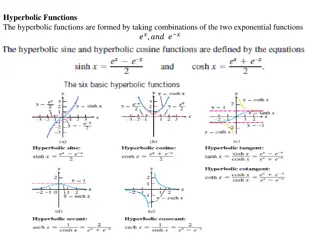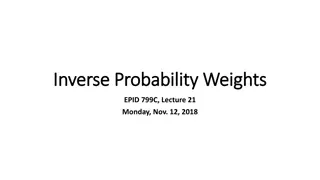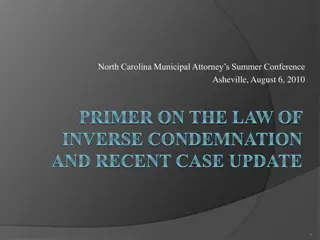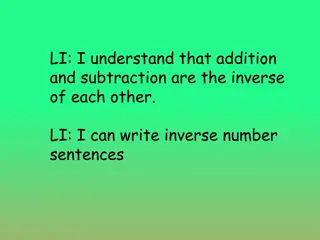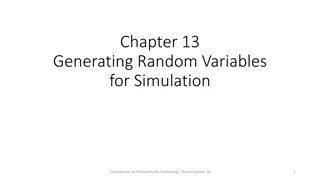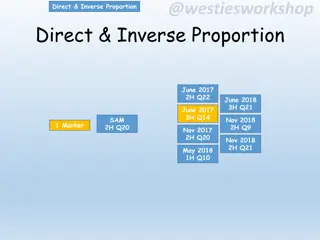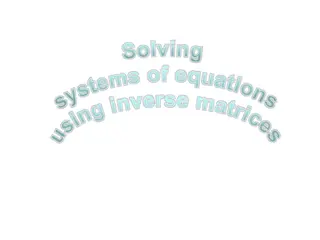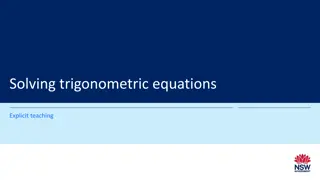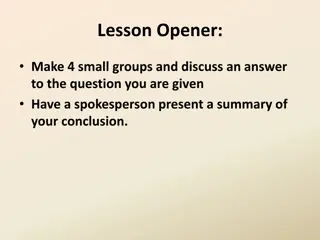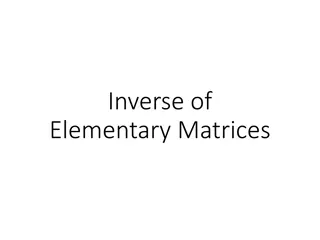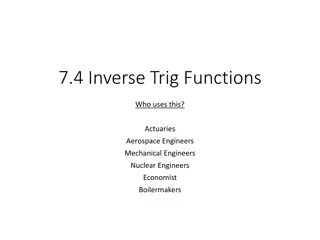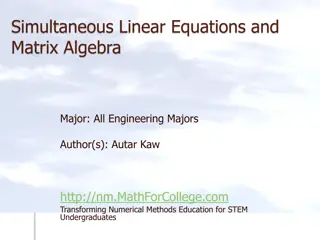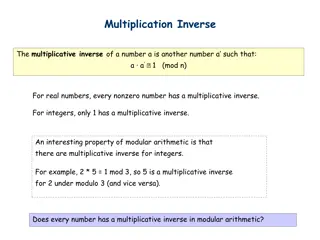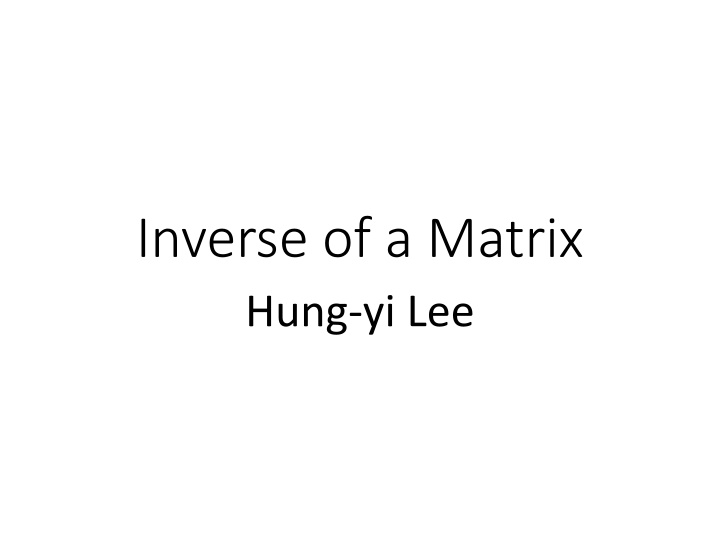
Matrix Inverses: Properties and Applications
Learn about matrix inverses, including their definition, properties, invertibility criteria, and applications. Discover how to find the inverse of a matrix and understand the difference between singular and non-singular matrices. Explore the concept of inverse functions and the invertibility of matrix products in this comprehensive guide.
Download Presentation

Please find below an Image/Link to download the presentation.
The content on the website is provided AS IS for your information and personal use only. It may not be sold, licensed, or shared on other websites without obtaining consent from the author. If you encounter any issues during the download, it is possible that the publisher has removed the file from their server.
You are allowed to download the files provided on this website for personal or commercial use, subject to the condition that they are used lawfully. All files are the property of their respective owners.
The content on the website is provided AS IS for your information and personal use only. It may not be sold, licensed, or shared on other websites without obtaining consent from the author.
E N D
Presentation Transcript
Inverse of a Matrix Hung-yi Lee
Inverse of a Matrix What is the inverse of a matrix? Elementary matrix What kinds of matrices are invertible Find the inverse of an invertible matrix
What is the inverse of a matrix?
Inverse of Function Two function f and g are inverse of each other (f=g-1, g=f-1) if For ??? ? ? = ? ? ? g ? = ? ? f ? = ? ? = ? ? f ? g ? = ? ? ? = ?
Inverse of Matrix If B is an inverse of A, then A is an inverse of B, i.e., A and B are inverses to each other. ?? = ? For ??? ? ? = ?? ? A B ? = ?? ? = ? B ? = ?? ? A ? = ?? ? = ? ?? = ?
Non-singular v.s. Singular Inverse of Matrix If B is an inverse of A, then A is an inverse of B, i.e., A and B are inverses to each other. A is called invertible if there is a matrix B such that ?? = ? and ?? = ? ? = ? 1 ? = ? 1 B is an inverse of A ?? =1 0 1 0 ? =1 2 5 ? = 5 2 3 3 1 ?? =1 0 1 0
Inverse of Matrix If B is an inverse of A, then A is an inverse of B, i.e., A and B are inverses to each other. A is called invertible if there is a matrix B such that ?? = ? and ?? = ? ? = ? 1 ? = ? 1 B is an inverse of A Non-square matrix cannot be invertible
Inverse of Matrix Not all the square matrix is invertible Unique ?? = ? ?? = ? ?? = ? ?? = ? ? = ?? = ? ?? = ?? ? = ?? = ?
Inverse for matrix product A and B are invertible nxn matrices, is AB invertible? yes ?? 1= ? 1? 1 ? 1? 1?? = ? 1? 1? ? = ? 1? = ? ?? ? 1? 1= ? ?? 1? 1 = ?? 1 = ? Let ?1,?2, ,?? be nxn invertible matrices. The product ?1?2 ?? is invertible, and 1= ?? 1?? 1 1 ?1 1 ?1?2 ??
Inverse for matrix transpose If A is invertible, is ATinvertible? ?? 1=? ? 1 ? ???= ???? ? 1? = ? ? 1??= ? ??? 1 ?= ? ?? 1 ?= ? ? 1 ???= ? ?? 1= ?
Solving Linear Equations The inverse can be used to solve system of linear equations. If A is invertible. ?? = ? However, this method is computationally inefficient.
Input-output Model 0.3 0.1 0.2 0.2 0.4 0.1 0.1 0.2 0.1 Cx x C ?1 ?2 ?3 0.1?1+ 0.2?2+ 0.1?3 0.2?1+ 0.4?2+ 0.2?3 0.3?1+ 0.1?2+ 0.1?3 0.1 0.2 0.3 Consumption matrix 0.2 0.4 0.1 0.1 0.2 0.1 =
Input-output Model x C Cx 100 150 80 0.1 0.2 0.3 Consumption matrix 0.2 0.4 0.1 0.1 0.2 0.1 48 96 53 = ? ?? = 52 54 27 100 150 80 48 96 53 Demand Vector d =
Input-output Model 0.1 0.2 0.3 0.2 0.4 0.1 0.1 0.2 0.1 90 80 60 Demand Vector d ? = ? = x ? 0.9 0.2 0.3 0.2 0.6 0.1 0.1 0.2 0.9 ? ?? = ? A = ? C = ?? ?? = ? 90 80 60 170 240 150 ? ? ? = ? ? = ? = Ax=b
Input-output Model Ans: The first column of ? ? 1 ? = ? ? 1? ? ? ? = ? ? = ? ? 1? + ?1 = ? ? 1? + ? ? 1?1 1 0 0 ? ? + = ? + ?1 1.3 0.6 0.5 0.475 1.950 0.375 0.25 0.50 1.25 ? ? 1=
Invertible A is called invertible if there is a matrix B such that ?? = ? and ?? = ? (? = ? 1) ? ? ? 1? ?? ? ? ? 1 ? 1
Summary Theorem 2.6 (P138) Let A be an n x n matrix. A is invertible if and only if The columns of A span Rn For every b in Rn, the system Ax=b is consistent The rank of A is n The columns of A are linear independent The only solution to Ax=0 is the zero vector The nullity of A is zero The reduced row echelon form of A is In A is a product of elementary matrices There exists an n x n matrix B such that BA = In There exists an n x n matrix C such that AC = In
Review: One-to-one A function f is one-to-one If co-domain is smaller than the domain, f cannot be one-to-one. ?1 ? ?1 If a matrix A is , it cannot be one-to-one. ?2 ? ?2 The reverse is not true. ? ?3 ?3 If a matrix A is one-to- one, its columns are independent. ? ? = ? has one solution ? ? = ? has at most one solution
Review: Onto A function f is onto If co-domain is larger than the domain, f cannot be onto. ?1 ? ?1 If a matrix A is , it cannot be onto. ?2 ? ?2 = ? ?3 The reverse is not true. ?3 If a matrix A is onto, rank A = no. of rows. Co-domain = range ? ? = ? always have solution
Invertible A is called invertible if there is a matrix B such that ?? = ? and ?? = ? (? = ? 1) ? ? ? 1? ?? ? ? ? 1 ? 1 A must be onto ( ? 1 input ) A must be one-to-one
An invertible matrix A is always square. One-to-one and onto A function f is one-to-one and onto The domain and co- domain must have the same size . The corresponding matrix A is square. ?1 ? ?1 ?2 ? ?2 ? ?3 ?3 Onto One-to-one Square
Invertible Let A be an n x n matrix. Onto One-to-one invertible The columns of A span Rn For every b in Rn, the system Ax=b is consistent The rank of A is the number of rows One-to-one Onto invertible The columns of A are linear independent The rank of A is the number of columns The nullity of A is zero The only solution to Ax=0 is the zero vector The reduced row echelon form of A is In Rank A = n
Invertible Let A be an n x n matrix. A is invertible if and only if The reduced row echelon form of A is In In Invertible RREF RREF Not Invertible
Summary Let A be an n x n matrix. A is invertible if and only if The columns of A span Rn For every b in Rn, the system Ax=b is consistent The rank of A is n The columns of A are linear independent The only solution to Ax=0 is the zero vector The nullity of A is zero The reduced row echelon form of A is In A is a product of elementary matrices There exists an n x n matrix B such that BA = In There exists an n x n matrix C such that AC = In onto square matrix = One-to- one
Invertible An n x n matrix A is invertible. There exists an n x n matrix B such that BA = In ? The only solution to Ax=0 is the zero vector If ?? = 0, then . ?? = ?? ? = 0 ??? = 0 ??? = ?
Invertible An n x n matrix A is invertible. There exists an n x n matrix C such that AC = In ? For every b in Rn, Ax=b is consistent For any vector b, ?? = ?? ?? is always a solution for ? ??? ??? = b
Summary Let A be an n x n matrix. A is invertible if and only if The columns of A span Rn For every b in Rn, the system Ax=b is consistent The rank of A is n The columns of A are linear independent The only solution to Ax=0 is the zero vector The nullity of A is zero The reduced row echelon form of A is In A is a product of elementary matrices There exists an n x n matrix B such that BA = In There exists an n x n matrix C such that AC = In onto square matrix = One-to- one
Inverse of Elementary Matrices
Elementary Row Operation Every elementary row operation can be performed by matrix multiplication. 1. Interchange elementary matrix 1 0 1 0 2. Scaling 0 1 0 k 3. Adding k times row i to row j: 0 1 k 1
Elementary Matrix Every elementary row operation can be performed by matrix multiplication. How to find elementary matrix? elementary matrix E.g. the elementary matrix that exchanges the 1stand 2nd rows 1 0 0 0 1 0 0 0 1 0 1 0 1 0 0 0 0 1 1 2 3 4 5 6 2 1 3 5 4 6 ? ? = = 0 1 0 1 0 0 0 0 1 ? =
Elementary Matrix How to find elementary matrix? Apply the desired elementary row operation on Identity matrix 1 0 0 1 0 0 1 0 0 0 1 0 0 1 0 0 1 0 0 0 1 0 0 1 0 0 1 1 0 0 1 0 0 1 0 2 0 0 1 0 1 0 Exchange the 2nd and 3rdrows ?1= 0 0 0 1 Multiply the 2nd row by -4 ?2= 4 0 0 1 0 0 0 1 Adding 2 times row 1 to row 3 ?3=
Elementary Matrix How to find elementary matrix? Apply the desired elementary row operation on Identity matrix 1 0 0 1 0 0 1 0 2 0 0 1 0 1 0 1 2 3 4 5 6 1 3 2 4 6 5 ?1= ? = ?1? = 0 0 0 1 1 4 ?2= 4 0 0 1 0 ?2? = 8 3 1 2 5 20 6 4 5 14 0 0 1 ?3= ?3? =
Inverse of Elementary Matrix Reverse elementary row operation Exchange the 2ndand 3rdrows Exchange the 2ndand 3rdrows 1 0 0 1 0 0 0 0 1 0 1 0 0 0 1 0 1 0 1= ?1= ?1 Multiply the 2ndrow by -4 Multiply the 2ndrow by -1/4 1 0 0 1 0 0 0 0 0 1 0 0 0 1 1= ?2= 4 0 ?2 1/4 0 Adding 2 times row 1 to row 3 Adding -2 times row 1 to row 3 1 0 0 1 0 0 0 1 1 0 2 0 1 0 0 0 1 1= ?3 ?3= 2
RREF v.s. Elementary Matrix Let A be an mxn matrix with reduced row echelon form R. ?? ?2?1? = ? There exists an invertible m x m matrix P such that PA=R ? = ?? ?2?1 1 1?2 1 ?? ? 1= ?1
Invertible An n x n matrix A is invertible. R=RREF(A)=In ?? ?2?1? = ?? The reduced row echelon form of A is In 1?? 1?2 1 ?? ? = ?1 1 1?2 1 ?? = ?1 A is a product of elementary matrices
Inverse of General Matrices
2 X 2 Matrix ? ? ? ? =? ? ? ? 1= Find ?,?,?, ? ? ? ? =1 0 1 ? ? ? ? 0 1 ? ? ? ? 1= ? ?? ?? If ?? ?? = 0, A is not invertible.
Algorithm for Matrix Inversion Let A be an n x n matrix. A is invertible if and only if The reduced row echelon form of A is In ?? ?2?1? = ? ? 1 = ?? ? 1= ?? ?2?1
Algorithm for Matrix Inversion Let A be an n x n matrix. Transform [ A In] into its RREF [ R B ] R is the RREF of A B is an nxn matrix (not RREF) If R = In, then A is invertible B = A-1 ?? ?2?1? = ? ?? ?? ?2?1 ? 1 ??
Algorithm for Matrix Inversion In Invertible RREF
Algorithm for Matrix Inversion Let A be an n x n matrix. Transform [ A In] into its RREF [ R B ] R is the RREF of A B is a nxn matrix (not RREF) If R = In, then A is invertible B = A-1 To find A-1C, transform [ A C ] into its RREF [ R C ] C = A-1C ? 1? = ? ?? ?2?1? ? 1 ?? ?2?1? ? ?? P139 - 140

